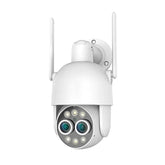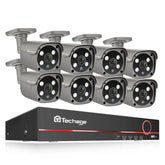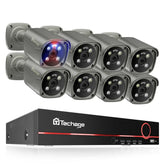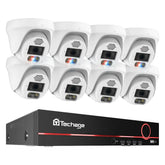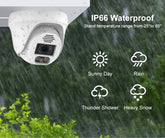The Rise of AI-Driven IP Cameras: Revolutionary Surveillance Technolog
Advancements in artificial intelligence (AI) have transformed various industries, and the field of surveillance is no exception. The integration of AI technology with IP cameras has brought about a revolutionary shift in the way we approach security monitoring. The field of video surveillance has experienced a significant transformation with the emergence of AI-driven IP cameras. These advanced devices, empowered by artificial intelligence algorithms, have revolutionized the way we monitor and secure our surroundings. In this blog post, we will explore the rise of AI-driven IP cameras and delve into the revolutionary impact they have had on surveillance technology.
Understanding AI-Driven IP Cameras:
AI-driven IP cameras combine the power of artificial intelligence and network camera technology to deliver groundbreaking surveillance capabilities. These cameras are equipped with embedded AI algorithms that enable them to analyze video data in real-time, extracting meaningful insights and enhancing their functionality beyond traditional surveillance systems.
Intelligent Video Analytics:
One of the key features of AI-driven IP cameras is their ability to perform intelligent video analytics. By leveraging AI algorithms, these cameras can automatically detect and identify objects, track their movements, and even recognize human faces or license plates. Intelligent video analytics enable proactive monitoring, quick identification of security threats, and efficient incident management.
Enhanced Security and Safety:
The integration of AI in IP cameras has significantly enhanced security and safety measures. AI-driven cameras can detect suspicious activities, unauthorized access, or abnormal behaviors and immediately trigger alerts or notifications. This capability enables security personnel to respond promptly to potential threats, preventing incidents before they escalate. Moreover, AI-driven IP cameras contribute to creating a safer environment for both individuals and properties.
Real-Time Monitoring and Alerts:
AI-driven IP cameras offer real-time monitoring capabilities, providing instant alerts and notifications based on predefined rules or events. The cameras can detect specific activities, such as intrusion attempts or loitering, and immediately alert security personnel or authorized individuals. Real-time monitoring and alerts ensure that security incidents are addressed promptly, improving response times and minimizing risks.
Advanced Object Detection and Tracking:
The advanced object detection and tracking capabilities of AI-driven IP cameras enable efficient surveillance in complex environments. These cameras can differentiate between humans, vehicles, animals, and other objects, allowing for targeted monitoring and analysis. Additionally, AI algorithms enable the tracking of objects across multiple camera feeds, providing comprehensive situational awareness.
Facial Recognition:
One of the most notable applications of AI in IP cameras is facial recognition technology. With AI algorithms, IP cameras can accurately identify and match faces against watchlists, enabling efficient access control and enhanced security measures. This feature finds applications in various settings, such as airports, banks, and large-scale events, where rapid identification and response are crucial.
Predictive Analytics and Proactive Alerts:
AI-driven IP cameras can learn from historical data and use predictive analytics to anticipate potential security risks. By detecting patterns and trends, these cameras can provide proactive alerts and recommendations, empowering security personnel to take preventive measures before incidents occur. For example, based on past data, the cameras can identify high-risk areas or time periods and suggest increased surveillance or additional security measures. This predictive capability enables a proactive approach to security, minimizing the likelihood of incidents and enhancing overall safety.With the integration of predictive analytics and proactive alerts, AI-driven IP cameras further enhance their role in ensuring comprehensive security and safety. By leveraging historical data and advanced algorithms, these cameras empower security personnel to stay one step ahead of potential threats and take proactive measures to mitigate risks. This proactive approach not only strengthens security but also contributes to overall operational efficiency and peace of mind for businesses, organizations, and individuals relying on surveillance systems.
Behavioral Analysis:
AI-driven IP cameras can analyze behavioral patterns and anomalies, helping to identify potential risks or abnormal activities. By learning from historical data, the cameras can establish baseline behaviors and detect deviations from the norm. This proactive approach to surveillance enables early detection of suspicious behavior, such as unusual movements or loitering, enabling security personnel to intervene promptly.
Integration with Security Systems:
AI-driven IP cameras seamlessly integrate with other security systems, such as access control, alarms, or facial recognition systems, creating a comprehensive security ecosystem. The integration allows for synchronized responses and enhances overall security measures. For example, when an AI-driven IP camera detects an unauthorized person, it can trigger access control mechanisms to deny entry and send alerts to security personnel.
Automation and Operational Efficiency:
AI-driven IP cameras automate several surveillance processes, reducing the need for manual monitoring and analysis. The cameras can continuously scan video feeds, freeing up security personnel to focus on critical tasks. The automation of surveillance tasks improves operational efficiency, reduces human error, and allows security teams to allocate their resources effectively.
Improved Forensic Analysis:
AI-driven IP cameras provide enhanced forensic analysis capabilities. The cameras can store metadata alongside video footage, making it easier to search and retrieve specific events or incidents. The AI algorithms also assist in extracting relevant information, such as facial features or object characteristics, to aid in post-event investigations.
Future Potential and Adaptability:
The rise of AI-driven IP cameras represents just the beginning of a transformative era in surveillance technology. As AI continues to advance, we can expect further improvements in video analytics, object recognition, and behavioral analysis.The adaptability of AI algorithms allows for continuous learning and refinement, enabling cameras to become more intelligent and efficient over time.
The combination of advanced analytics and cloud storage enables powerful features and functionalities.
Firstly, AI algorithms applied to video footage can optimize storage usage by selectively recording and storing events of interest. Rather than storing continuous video streams, the cameras can intelligently identify and capture specific events, such as motion detection or specific objects, minimizing storage requirements and maximizing storage efficiency.Secondly, cloud storage offers seamless access to video recordings from anywhere, at any time. Users can securely access and review footage remotely using web-based or mobile applications, eliminating the need for on-site storage infrastructure. This flexibility allows for convenient monitoring, retrieval, and sharing of recorded video, enhancing situational awareness and collaboration.
Moreover, AI-driven IP cameras integrated with cloud storage enable advanced search capabilities. AI algorithms can automatically tag and categorize recorded events based on detected objects, behaviors, or attributes. This tagging facilitates quick and efficient retrieval of specific footage, saving time and effort during investigations or audits.
Additionally, cloud storage provides redundancy and data backup, minimizing the risk of data loss due to hardware failures or physical damage. Automatic backups ensure the preservation and integrity of recorded video, providing peace of mind and ensuring the availability of evidence when needed.
In summary, AI-driven IP cameras combined with cloud storage offer a powerful and comprehensive video surveillance solution. The integration of artificial intelligence enables intelligent analysis, efficient storage utilization, and advanced search capabilities. Cloud storage further enhances accessibility, scalability, and data protection, making it a valuable component of modern video surveillance systems.
The advent of AI-driven IP cameras has revolutionized the field of surveillance, introducing a new era of intelligent monitoring and enhanced security. With features such as intelligent video analytics, facial recognition, behavior analysis, object detection, and smart search capabilities, these cameras empower businesses, organizations, and authorities to proactively address security challenges. these cameras provide a comprehensive and proactive approach to surveillance. As the technology continues to evolve, AI-driven IP cameras hold immense potential to shape the future of security and safety, making our environments more secure, efficient, and resilient.As AI technology continues to advance, we can expect further advancements in AI-driven IP cameras, making them even more indispensable in the ever-evolving landscape of surveillance and security.




